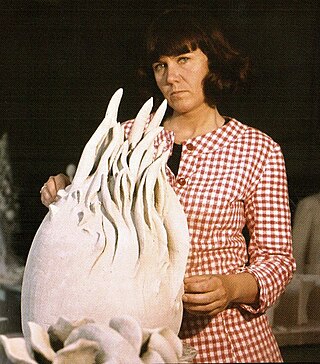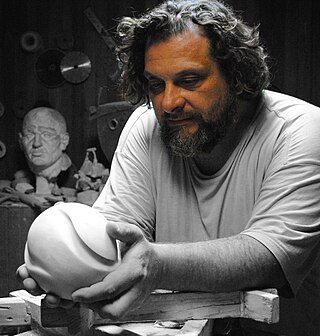Education and career
He graduated at the Belgrade Art Academy with an M.A. Gligor Stefanov has participated in eighteen one-man exhibitions and in more than 100 group exhibitions in many countries, including the Venice Biennale, in Italy. [2]

Gligor Stefanov (born 1956 SR Macedonia, SFR Yugoslavia) is a sculptor and environmental installations artist, who lives in Windsor, Ontario, Canada. [1]
He graduated at the Belgrade Art Academy with an M.A. Gligor Stefanov has participated in eighteen one-man exhibitions and in more than 100 group exhibitions in many countries, including the Venice Biennale, in Italy. [2]

He creates site-specific works, paintings and drawings, religious and eco-art with organic materials. [3] From the beginning of his career, Stefanov treated sculpture as an object or an installation of objects situated in space. In 1988, narrative aspects of his work shifted from mythology to religion. In the late 1980s and early 1990s, he produced a series of objects and installations, in the form of angels' wings and discs, executed in straw and boards or tree trunks and branches. [4]
Stefanov has participated in more than 100 group exhibitions since 1973, among which are:
Source: [2]

Edo Murtić was a painter from Croatia, best known for his lyrical abstraction and abstract expressionism style. He worked in a variety of media, including oil painting, gouache, graphic design, ceramics, mosaics, murals and theatrical set design. Murtić travelled and exhibited extensively in Europe and North America, gaining international recognition for his work, which can be found in museums, galleries and private collections worldwide. He was one of the founders of the group "March" (Mart) in 1956, and received many international awards. In 1958 Murtić participated in the three biggest events in the world of contemporary art: the Venice Biennale, the Carnegie Prize in Pittsburgh, and Documenta in Kassel. Interest in the art of Edo Murtić continues to grow, with retrospective exhibits in major museums.
Oton Gliha was a Croatian artist, born in Slovenia. A graduate of the Academy of fine Arts in Zagreb, Gliha continued his studies in Paris, Vienna and Munich. He is best known for his series of abstract paintings based on the patterns of the drystone walls of coastal Croatia. The first in the series appeared in 1954, and it was a theme he developed for the rest of his life.

Petar Lubarda ; 27 July 1907 – 13 February 1974) was a Serbian painter.

Aux Maniere, later AUX Manir Slobodan Sajin was a contemporary art group from Serbia in 1982-2009, established by Slobodan Šajin (1952–2009) and Momčilo Rajin (1954).
Elpida Hadzi-Vasileva is a site specific installation artist who works across sculpture, installation, and architectural interventions.
Vessna Perunovich is a Yugosla-born, Canadian / Serbian visual artist based in Toronto, Ontario and Belgrade, Serbia. She was born in 1960 in Zaječar, Serbia, FPR Yugoslavia. Her father was originally from Montenegro and her mother was from Serbia, born in North Macedonia. She immigrated with her family husband and daughter to Toronto in 1988. She earned her B.F.A in 1984 at the Academy of Fine Arts at the University of Belgrade, Yugoslavia. She earned her M.F.A. also from the Academy of Fine Arts at the University of Belgrade in 1987. In 2004, she was invited to the University of Guelph in Ontario to guest lecture. In 2004 she was invited to participate at the thematic Artist Residency Informal Architectures Symposium in Banff, Alberta to create work and to do an artist presentation. She was a sessional teacher at the Ontario College of Art and Design in Toronto from 2005 until 2011. Her most recent artist presentation was at the Museum of Contemporary Art Belgrade coinciding with her solo survey exhibition at the Gallery-Legacy Milica Zorić and Rodoljub Čolaković in 2023. Other artist presentation include Ontario College of Art and Design in Toronto and the other one in Havana, Cuba for the "International Artists' Presentation".

Mirjana Isaković is a Serbian sculptor and ceramist.
Dragan Malešević Tapi was a Serbian painter. Although by vocation an economist, he is generally considered one of the leading painters of Serbian hyperrealism style.

Radomir Damnjanović Damnjan is a Serbian-Italian painter and conceptual artist. Over the course of his six-decade career, he has consistently pushed the boundaries of traditional art forms, challenging conventional understandings of creativity, authorship, and representation. His artistic practice encompasses a diverse range of media, such as painting, photography, video and installation.

Zharko Basheski is a Macedonian sculptor and professor in the Sculpture Department at the Faculty of Fine Arts in Skopje. His work falls under the hyperrealism movement, with a specific focus on the human body.

Jovanka Stanojević is a Serbian painter.

Mihailo Stošović is a Serbian sculptor, also known as Vajar Beogradski.
Iskra Dimitrova is a multimedia artist in the Republic of Macedonia.

„Cvijeta Zuzorić“ Art Pavilion is an exhibition building in Belgrade, in Kalemegdan, situated in the park's section of Little Kalemegdan, next to the south-eastern front of the Belgrade fortress. It was built between 1927 and 1928 after the design of the architect Branislav Kojić, in the Art Deco architectural style. It was the first venue built specifically as an exhibition space, or an art gallery, in Serbia.

The art of Yugoslavia is the visual art created by a number of painters, sculptors and graphics artists in Yugoslavia.
Ana Vidjen is a Yugoslav, Croatian and Serbian sculptor. She obtained her MA in sculpture in 1962 at Athens School of Fine Arts, and was encouraged in her chosen field by the Greek feminist poet and writer Eleni Vakalo as well as the painter Milo Milunovic, who founded the Academy of Fine Arts in 1937. Her work includes sculptures in stone, wood and bronze, drawings, paintings and ceramics.
Vasa Pomorišac was a Serbian artist and professor at the Academy of Applied Arts in Belgrade. He worked as a painter, stained glass window maker, etcher, printmaker and he was also an art critic. He is considered an expressionist painter in the same category as his contemporaries Mihajlo Petrov, Ivan Radović, Petar Dobrović, and Jovan Bijelić.

Natalija Cvetković was a Serbian war artist.
Radojica Živanović Noe was a painter and graphic artist of the period of Surrealism and a writer. He left a small number of compositions, still lifes, landscapes and drawings. The most significant period of Živanović's artistic creation is his affiliation with the Surrealist movement (1930–33). He was one of the thirteen signatories of the Manifesto of Surrealism and the only professional painter in the group of artists who initiated the Belgrade Surrealist movement.

Nemanja Vučković is a Serbian painter.